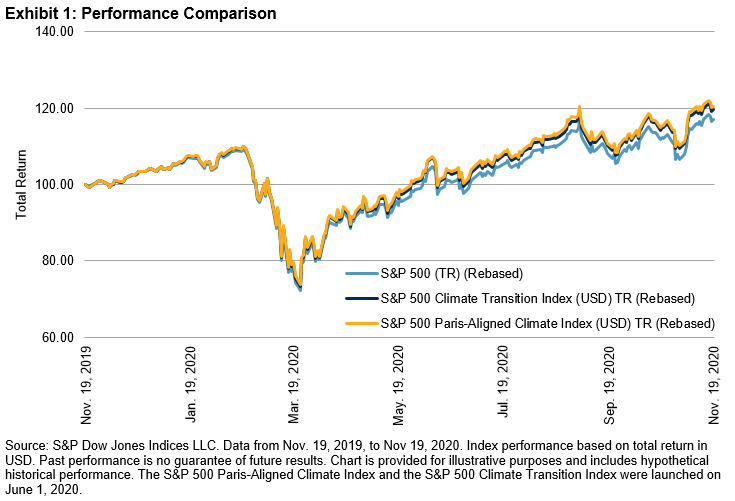Could the range of potential applications for gold be broader than some investors may think? S&P DJI’s Fiona Boal and Jim Wiederhold take a closer look at how and why gold is being put to work in portfolios today.
The posts on this blog are opinions, not advice. Please read our Disclaimers.Mining for Opportunities with Gold
Where Are Yield Seekers Uncovering Potential Income Opportunities?
Biden 1, Climate Change 1.5
A European Perspective on the U.S. Mid-Cap Sweet Spot
The Dangers of Extrapolation
Mining for Opportunities with Gold
Where Are Yield Seekers Uncovering Potential Income Opportunities?
While ongoing market uncertainty has dampened property transactions in Asia and bond yields continue to lag, expanded access to REITs could provide a potential income source for yield seekers in Asia. Samsung Asset Management’s Alex Yang joins S&P DJI’s Priscilla Luk for a closer look at how indexing works for REITs in Asia.
The posts on this blog are opinions, not advice. Please read our Disclaimers.
Biden 1, Climate Change 1.5

- Categories Sustainability, Thematics
- Tags 1.5C Scenario, 2020, Biden, climate, climate change, elections, ESG, Jaspreet Duhra, Net Zero, PACT, Paris Agreement, Paris Climate Agreement, Presidential Election, S&P PACT, S&P PACT Indices, S&P Paris-Aligned & Climate Transition Indices, sustainability, U.S. Election
“Today, the Trump Administration officially left the Paris Climate Agreement. And in exactly 77 days, a Biden Administration will rejoin it.” –Joe Biden, Nov. 4, 2020. 1
In a crowded field for “standout tweets from a U.S. president or president-elect,” for those of us who have dedicated careers to tackling sustainability challenges, this may be the most memorable tweet of them all.
Now, of course, we don’t want to be too premature in our celebrations. There are still several months until the inauguration of President-Elect Joe Biden and there are practical hurdles that need to be cleared. However, initial signs are promising, with the Biden transition team announcing John Kerry as special envoy on the climate crisis, a position that for the first time will include a seat on the National Security Council.2
What is the Paris Agreement and why does it matter so much that the U.S. rejoins? The Paris Agreement “sets out a global framework to avoid dangerous climate change by limiting global warming to well below 2°C and pursuing efforts to limit it to 1.5°C,3” as recommended by the Intergovernmental Panel on Climate Change (IPCC).
The U.S. is the world’s largest economy and is currently the second-largest emitter of greenhouse gases.4 According to Climate Action Tracker, the U.S. pledge for net zero emissions by 2050, along with similar commitments from China, EU, Japan, and South Korea, means a tipping point is being approached that puts the goal of limiting warming to 1.5°C within reach.5
However, this is no reason for complacency. Alignment with the 1.5°C goal is not a commitment just for governments. The achievement of such an ambitious goal arguably requires participation from all stakeholders, including investors. Climate change ranks as the “highest priority ESG issue facing investors,” according to the Principles for Responsible Investment (PRI).6 Investment portfolios and products may be exposed to climate risks as follows:
- Transitional risks of climate change (e.g., stranded assets, rising carbon prices, etc.); and
- Physical risks of climate change (e.g., sea level rise, hurricanes, etc.)
But it isn’t just climate change risks that investment product providers should consider; there are also opportunities available to potentially finance the transition to a lower-carbon economy.
What are the practical tools available to investment product providers who want to manage the risks and opportunities and align their investment products with the Paris Agreement?
At S&P DJI, we have created two benchmarks that align with the 1.5°C scenario: the S&P Paris-Aligned Climate Indices and the S&P Climate Transition Indices, together known as the S&P PACTTM Indices (S&P Paris-Aligned & Climate Transition Indices). The S&P PACT Indices offer an information tool for investment product providers looking to address a number of climate objectives while still staying as close as possible to the underlying benchmark index.
The S&P Paris-Aligned Climate Indices set stricter relative decarbonization objectives of the two benchmarks and include a range of fossil fuel exclusions. The S&P Climate Transition Indices still incorporate significant relative decarbonization objectives but are designed for broader exposure. Crucially, both sets of indices decarbonize at an absolute rate of 7% year-over-year, in line with, or beyond, the decarbonization trajectory from the IPCC’s 1.5°C scenario. From a U.S. equities perspective, the S&P 500® Paris-Aligned Climate Index and the S&P 500 Climate Transition Index both outperformed the broad U.S. benchmark over a period of one year.

There are of course great challenges ahead. President-Elect Biden now has to consensus build and implement strategies to meet ambitious climate targets. We have already seen major investors taking the lead in aligning their investments to the 1.5°C scenario. Benchmarks such as the S&P PACT Indices are designed to make this vital transition much more feasible.
1 https://twitter.com/JoeBiden/status/1324158992877154310
2 https://www.theguardian.com/us-news/2020/nov/23/john-kerry-biden-climate-envoy-appointment
3 https://ec.europa.eu/clima/policies/international/negotiations/paris_en
4 https://www.theguardian.com/us-news/2020/nov/08/joe-biden-paris-climate-goals-0-1c
6 https://www.unpri.org/climate-change. The PRI is a UN-supported international network of investors working together to implement its six aspirational principles.
The posts on this blog are opinions, not advice. Please read our Disclaimers.A European Perspective on the U.S. Mid-Cap Sweet Spot
Should European investors be looking beyond large-cap U.S. equities for core exposure? S&P DJI’s Tim Edwards and State Street Global Advisors’ Rebecca Chesworth explore the case for U.S. mid-caps through broad and tactical sector exposures.
The posts on this blog are opinions, not advice. Please read our Disclaimers.
The Dangers of Extrapolation

The contrasts between the first 10 months of 2020 and the month of November were vivid. Consider:
- At the end of October, the year-to-date total return of the S&P 500® was barely positive (2.77%), but was well ahead of the returns of the S&P MidCap 400® (-6.63%) and the S&P SmallCap 600® (-13.06%). In November, the 500TM performed very well (10.95%), but the 400TM (14.28%) and the 600TM (18.17%) did much better.
- At the end of October, the cap-weighted S&P 500 had outperformed the average stock in the index (the S&P 500 Equal Weight) by 8.10%. In November, the equal-weight index outperformed by 3.35%.
- At the end of October, the best-performing sectors were Information Technology (22.13%) and Consumer Discretionary (19.76%), while the forlorn Energy sector had lost more than 50% of its value in 10 months. In November, Energy rose by 28.03%, well ahead of the erstwhile leaders.
- At the end of October, the best-performing factor indices were Growth (16.89%) and Momentum (15.97%), while value-based factors had all suffered double-digit declines. In November, the S&P 500 Enhanced Value Index rose by 19.82%, handily outperforming the growth and momentum indices.
- At the end of October, VIX® stood at 38.02, a high level. In November, VIX fell to 20.57, as expectations of future volatility declined.
To summarize, there were market reversals on numerous fronts.
All this may be interesting as a matter of short-term market commentary, but its importance lies in what it illustrates about the fragile persistence of relative winners in equity markets and the risks of extrapolation from the past. These risks help explain two major long-term trends: the consistent underperformance of active managers and the consequent flow of assets to index funds.
Why, we are sometimes asked, do some investors remain loyal to active managers, despite all the evidence to the contrary? One obvious explanation is the natural human tendency to assume that the past predicts the future. In most of life, this isn’t a bad heuristic; the past does predict the future quite often. In some ways our routine daily lives depend on this assumption. Although COVID has kept me away from London for nearly a year, I’m confident that the cars there still drive on the left—because they always have. Investors often make an analogous assumption—they assume that good historical performance predicts good future performance.
And November’s results, in a microcosm, show why this assumption can be dangerous. Almost any extrapolation based on performance through October turned out to be wrong; past performance did not predict future returns. Those who assumed that it would are likely to be disappointed with their results—although perhaps not disappointed enough to forswear active management altogether.
The posts on this blog are opinions, not advice. Please read our Disclaimers.

